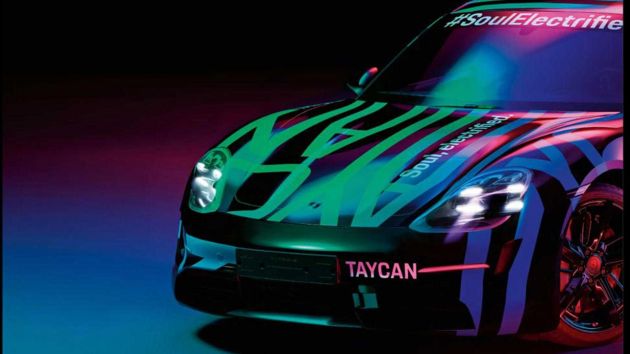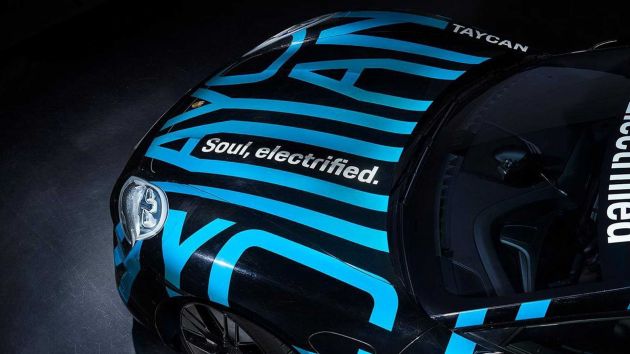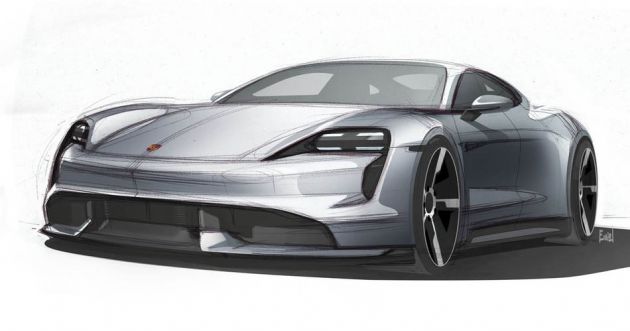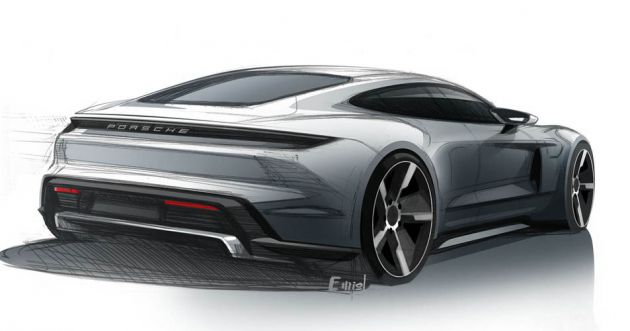Last week, Porsche released official sketches of the upcoming Porsche Taycan electric car, which is set to surface in September and reach Malaysia next year. Here’s the actual production car, teased in a series of neon-lighted images that remind me of our recent Mercedes-AMG G63 gallery.
The images appear in Porsche’s Annual & Sustainability Report 2018, where also sees the Taycan project leader explain the car, and the philosophy behind it. Stefan Weckbach used to be head of the Boxster model line, but has been in charge of the Taycan project since November 2014. It’s a big role, overseeing one of the most demanding tasks which Porsche currently has to offer.
The Taycan is a revolutionary car with a completely new plant at the headquarters in Zuffenhausen. An additional 1,500 employees are being hired here and, in the course of the electric mobility campaign, around six billion euros will be invested by the carmaker.
Now, “revolutionary” isn’t always the word used to describe the maker of the 911, known for its incremental “evolutionary” approach, but the Taycan will see Porsche point the way to the future and return to its roots at the same time.
Weckbach’s mission is to prove that the brand can, at the same time, renew itself and remain true to itself. “As the first fully electrical Porsche, the Taycan has to show that it is a fully-fledged member of the Porsche brand. Of course, this is a great challenge – and a huge expectation, both internally and externally.”
Expectations are high because the Taycan isn’t a one-off electric experiment, but a pioneer of a whole series of partially or fully electric Porsche models that will debut in the next few years. The company’s plan is to have more than 50% of new vehicles sold to have an electrical drive as early as 2025. A lot weighs on how the Taycan and its high-riding Cross Turismo sister – set for 2020 – will prove themselves on the road and market.
The author of the “Evolution meets revolution” piece in Porsche’s annual report sums up the juggling act the carmaker will have to pull off.
“It has to keep its fans excited and simultaneously gain new customers who may have no idea today that they will decide to buy a Porsche tomorrow. The brand must do one thing with out losing track of the other. To put it in driving terms, it must keep in its lane and pull out at the same time – at high speed. How can such a manoeuvre be carried out without being torn apart by centrifugal forces?” Harald Willenbrock asks.
No worry, because the people in Porsche are bigger fans of the brand than you, the non-owner car guy keyboard warrior. “Every now and then, people from outside say that we have to be careful not to lose our DNA. I don’t see any danger of that. Our people live and love Porsche. For them, their work is more than just a job. This means that, in reality, they themselves are the most careful preservers of the Porsche gene,” says August Achleitner, the man who has been head of the 911 model line for 18 years.
The way the company preserved the 911 augurs well. Wolfgang Porsche, grandson of Ferdinand Porsche and Chair of the Supervisory Board of Porsche AG reminds us that today’s 911 shares no single part with its 1960s ancestor, and yet the essential core of the icon has remained the same.
“That’s because it is not the technical details that constitute the identity of a 911. The decisive factor is that a thing remains true to its own essence. And I don’t know of any car which has remained so unchanged in its essence, despite all the technological and Zeitgeist-related changes, as the 911,” he said.
Faced with a changing world, the first Porsche EV is simply “the next logical step,” says Weckbach, who insists that the Taycan wouldn’t be just another premium EV, but a Porsche, even if it will be more digital and won’t have an engine.
“That wouldn’t be enough for us. A Porsche must offer reproducible performance, which means that it has to offer the highest performance at a constant level,” he says, with reference to some sporty EVs on the market with strong initial acceleration, only to reach a performance wall.
Weckbach says that his colleagues are working under pressure to adjust many “decisive last screws” in order to achieve this goal. For example, on intelligent cooling systems, on the elements of the 800-volt technology, on a longer range, on short charging cycles and of course, on driving dynamics befitting a Porsche.
ICE aside, there are many things that make a Porsche. Design wise, it’s the sporty flyline, the flared hip, the contour of the windows, the four-point daytime driving lights and the slender head on broad shoulders of current cars – these are all on the Taycan. Weckbach adds driving dynamics, emotion, quality and performance to the list.
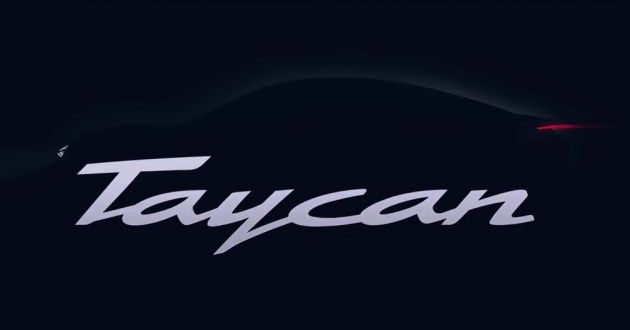

“What characterises a purebred Porsche is the fact that it always actively involves its driver. And this philosophy is contained in the Taycan, just as much as in the 911. The adjustment period from one vehicle to the next takes a few minutes. If even that,” says Achleitner, the 911 man who thinks that the drive system is only a part of a car.
That part of the Taycan will consist of two permanently synchronous motors that provide a total system output of over 600 PS. Zero to 100 km/h sprint will be under 3.5 seconds, and the run to 200 km/h will be below 12 seconds. The EV will be capable of 500 km on a single charge (NEDC) and fast charging will provide 100 km of range in just four minutes. Base car aside, one can expect “4S” and “Turbo” variants.
Don’t sigh, because Porsche didn’t, according to Achleitner. Instead of resisting electric, “on the contrary, a self-confident attitude prevailed: let’s show them that we, too, can make a fully electrical sports car. Something that has never existed before – just as when we made the first sporty SUV a few years ago with the Porsche Cayenne.”
Ah, the Cayenne. Remember the hate Porsche received when that one came out in 2002? Now, look at how successful that car has been for Zuffenhausen.
Source: Read Full Article

